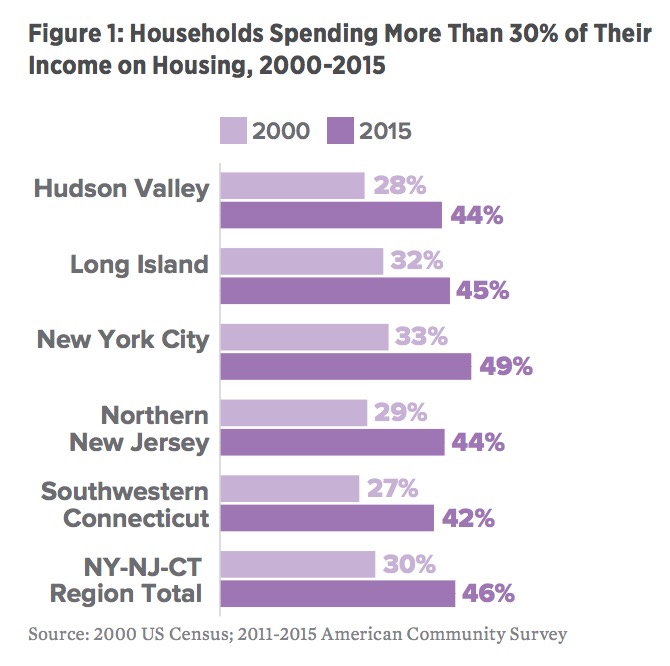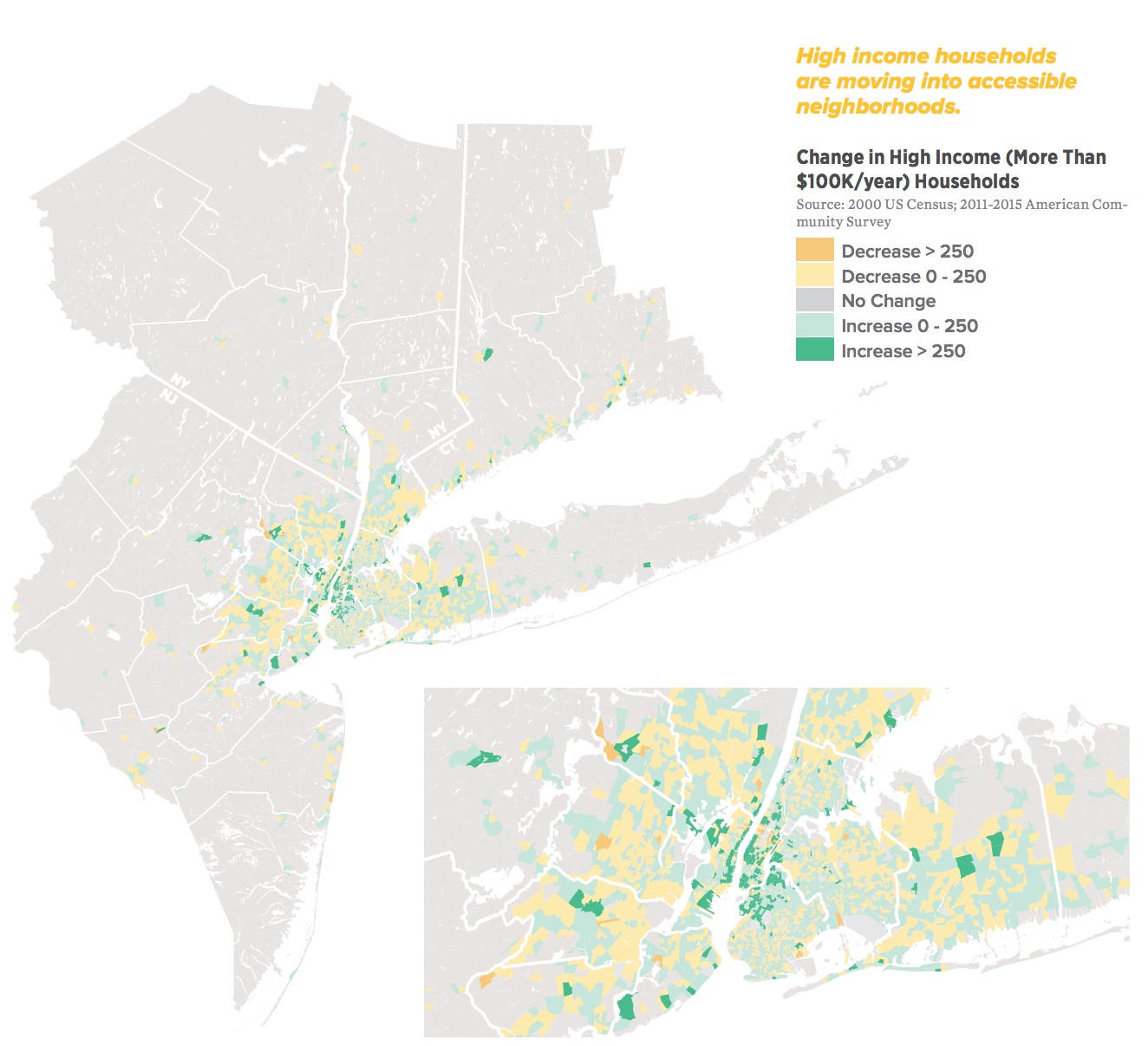REGIONAL PLAN ASSOCIATION (RPA)
 Over the past decades, New York City and much of the surrounding region has experienced a remarkable turnaround. Our robust transit system, walkable neighborhoods, reduced crime and diverse and international character have positioned New York City, and some other places in the region, as leaders of the recent urban renaissance.
Over the past decades, New York City and much of the surrounding region has experienced a remarkable turnaround. Our robust transit system, walkable neighborhoods, reduced crime and diverse and international character have positioned New York City, and some other places in the region, as leaders of the recent urban renaissance.
But this success has come at a price. Housing costs have skyrocketed even as wages have stagnated. Some outer borough neighborhoods that were once thought of as bastions of the working- and middle-class have seen a surge of wealthy residents. The idea that people can find a comfortable place to put down community roots for the long term is increasingly precarious. The pressure on poorer residents to leave for more distant areas and make way for people who can afford more has seemingly moved from neighborhood to neighborhood with little slowdown, overcoming recessions, natural disasters, and concerted efforts from government and community organizations alike. There is a common thread in the areas experiencing these pressures: They are walkable areas with good access to jobs and public transit. And they also are the areas where the people most vulnerable to displacement are likely to live.
The rising gap between housing costs and incomes can strain budgets and limit housing choices even for many middle-class individuals and families. This report focuses on the impact of rising rents and neighborhood change on low and moderate-income households. These residents not only have fewer choices when they are priced out of their homes, they are also more likely to live in the neighborhoods where the biggest changes are taking place. And the instability caused by displacement has a much bigger impact on the lives of people with few resources to adapt to the resulting financial, social and psychological disruption.
RPA conducted a detailed analysis of not just New York City, but the entire metropolitan region, in order to determine three things:
- Where are residents vulnerable to displacement?
- Where are the neighborhoods that are likely to experience gentrification and displacement pressures in the future, and how do they overlap with the vulnerable populations?
- .Where are the areas currently seeing the kind of housing market activity that can lead to price pressures and displacement?
Our findings were supplemented with interviews with low- and moderate- income residents of the region in order to understand their current living conditions, experiences with displacement, and future housing hopes. Interviewees were reached through RPA’s fourth regional plan community engagement program.
Key Findings
Low and moderate-income residents are being replaced by wealthier populations in walkable neighborhoods with good access to jobs.
From 2000 – 2015, households making more than $100,000 a year have grown by 160,000 in these accessible neighborhoods, while households making less than $100,000 have declined by 61,000 in these same neighborhoods1 . Households making under $25,000 in particular are seeing a marked shift, growing by almost 50,000 households in the less accessible neighborhoods, while declining by over 10,000 households in the more accessible ones. This shift isn’t equal across the region, and is heavily driven by the increase of the wealthy population in walkable, job-accessible neighborhoods in Manhattan, Brooklyn, and to a lesser extent Queens and New Jersey’s Hudson County.
Despite this shift, most low and moderate-income residents still live in these walkable, job-accessible neighborhoods.
Over 95% of neighborhoods with high proportions of vulnerable residents are also accessible areas. Out of the 2.1 million households in these neighborhoods at risk almost half of them, 990 thousand, are renters who earn less than $50,000 per year and are not living in public housing or other income-contingent housing. While some of these renters have other, weaker forms of rent protections, many will have little recourse against being pushed out if housing costs rise.
This is true not just in New York City, but throughout the region. In every part of the New York-New Jersey-Connecticut metropolitan area – southwestern Connecticut, northern New Jersey, Long Island and the Hudson Valley – at least two-thirds of the vulnerable neighborhoods are in these types of accessible areas.
These residents are mostly people of color.
Neighborhoods that are both home to significant vulnerable populations and are walkable, job-accessible neighborhoods are 69% black and Hispanic, compared with 26% black and Hispanic in the rest of the region. And while the amount of this discrepancy varies by county, in every county in the region these at-risk areas have a higher proportion of black and Hispanic residents than the rest of the county.
Many of these walkable, accessible neighborhoods are seeing a shift to more expensive housing.
46% of these neighborhoods have seen a recent shift toward an expensive housing market, with significant increases in the proportion of homes renting for more than $2,000 or being valued at more than $500,000. Again, this phenomenon is not limited to New York City, and occurs throughout the region, from 39% of the tracts in southwestern Connecticut to 52% of the neighborhoods on Long Island.
Displacement risk a problem throughout the region, not just in New York City.
While about two-thirds of the low-income population living in at-risk neighborhoods are in New York City, municipalities with walkable neighborhoods from New Brunswick, N.J., to Poughkeepsie, N.Y., to New Haven, Conn., also have significant populations at risk. And while New York City has the largest stock of subsidized and regulated housing in the United States, which act in varying levels as barriers to displacement of low- and moderate-income households, rent protections and subsidized housing stock outside of New York City are generally much less robust.
These findings highlight an imperative: As municipalities across the region succeed in attracting growth and development over the coming decades, they must take strong action to protect economically and socially vulnerable residents, both to address discriminatory policies of the past and to preserve the economic diversity critical to healthy local economies. The region’s affordability crisis can only be solved if we build enough new homes that are affordable to households with a range of income levels. But new development doesn’t have to come at the expense of existing residents. There are many approaches that can help protect vulnerable residents from displacement due to escalating price pressures. This report outlines five potential strategies:
- Limit evictions through access to legal counsel for low-income residents. “Right to counsel” legislation and funding should be expanded across the region. Right to counsel was recently adopted in New York City but is absent elsewhere in the metropolitan area. While there are legal protections for households facing evictions, especially unjustified ones, many low-income residents simply don’t have the funds to hire legal counsel and exercise these rights.
- Prevent sudden, sharp rent increases and keep homes safe and healthy, by strengthening municipal laws which can limit rent increases, as currently allowed in New York and New Jersey, and through enabling legislation that would extend this possibility to Connecticut municipalities as well.
- Help more low-income people pay their rent, through expanding funding for housing cost burdened low-income households, similar to the current federal Section 8 program, on the state and/or local level.
- Use vacant government-owned land for permanently protected housing for low-income households by keeping it public or transferring it to local nonprofit community control.
- Consider displacement risk in local decision making, including land use, grant funding, housing subsidies and tax benefits; and put in place proactive protections for at-risk residents while it is still affordable for local governments to do so.
Download full version (PDF): Housing Displacement in an Unaffordable Region
About Regional Plan Association (RPA)
www.rpa.org
For 90 years, Regional Plan Association has been an indispensable source of ideas and plans for policy makers and opinion shapers across the tri-state region. RPA is America’s most distinguished urban research and advocacy organization. RPA works to improve the prosperity, infrastructure, sustainability and quality of life of the New York-New Jersey-Connecticut metropolitan region.
Tags: Gentrification, Housing, New York City, NYC, Regional Plan Association, RPA, Walkability







 RSS Feed
RSS Feed